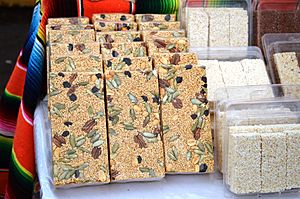Amaranth grain facts for kids
Amaranth is a special plant that has been grown for its seeds for over 8,000 years! Even though its seeds look and are used like grains such as wheat or rice, amaranth is actually a "pseudocereal." This means it's not from the same plant family as true cereals. People grow amaranth for its starchy, edible seeds. Some common types of grain amaranth include Amaranthus caudatus, Amaranthus cruentus, and Amaranthus hypochondriacus. Amaranth plants can produce as much grain as rice or corn.

| Nutritional value per 100 g (3.5 oz) | |
|---|---|
| Energy | 1,554 kJ (371 kcal) |
|
65 g
|
|
| Sugars | 1.7 g |
| Dietary fiber | 7 g |
|
7 g
|
|
|
Protein
|
14 g
|
| Vitamins | Quantity
%DV†
|
| Thiamine (B1) |
9%
0.1 mg |
| Riboflavin (B2) |
17%
0.2 mg |
| Niacin (B3) |
6%
0.9 mg |
| Pantothenic acid (B5) |
30%
1.5 mg |
| Vitamin B6 |
46%
0.6 mg |
| Folate (B9) |
21%
82 μg |
| Minerals | Quantity
%DV†
|
| Calcium |
16%
159 mg |
| Iron |
58%
7.6 mg |
| Magnesium |
70%
248 mg |
| Manganese |
162%
3.4 mg |
| Phosphorus |
80%
557 mg |
| Potassium |
17%
508 mg |
| Zinc |
31%
2.9 mg |
| Other constituents | Quantity |
| Water | 11 g |
| †Percentages estimated using US recommendations for adults. | |
| Nutritional value per 100 g (3.5 oz) | |
|---|---|
| Energy | 429 kJ (103 kcal) |
|
19 g
|
|
| Dietary fiber | 2 g |
|
2 g
|
|
|
Protein
|
4 g
|
| Vitamins | Quantity
%DV†
|
| Thiamine (B1) |
2%
0.02 mg |
| Riboflavin (B2) |
2%
0.02 mg |
| Niacin (B3) |
2%
0.24 mg |
| Vitamin B6 |
8%
0.1 mg |
| Folate (B9) |
6%
22 μg |
| Minerals | Quantity
%DV†
|
| Calcium |
5%
47 mg |
| Iron |
16%
2.1 mg |
| Magnesium |
18%
65 mg |
| Manganese |
43%
0.9 mg |
| Phosphorus |
21%
148 mg |
| Potassium |
5%
135 mg |
| Zinc |
9%
0.9 mg |
| Other constituents | Quantity |
| Water | 75 g |
| †Percentages estimated using US recommendations for adults. | |
Contents
History of Amaranth
Amaranth was a very important food for the Aztecs in ancient Mexico. It was a main part of their diet and even used in their religious ceremonies. When the Spanish conquerors arrived, they banned growing amaranth. This was because of its strong connection to Aztec religious practices.
However, the plant kept growing as a wild plant, like a weed. This helped keep its genetic makeup safe. In the 1970s, people in the United States started researching amaranth again. By the end of that decade, thousands of acres were being farmed. Today, amaranth is still grown in many places.
Modern Uses of Amaranth
Most amaranth grain today is sold in health food shops. It is also grown as a food crop in parts of Mexico. There, it is used to make a sweet treat called alegría. This word means "joy" in Spanish, and it's often eaten during festivals.
Amaranth grain can be prepared in many ways:
- It can be popped like popcorn. You can then mix it with honey.
- It can be served with milk, dried fruit, and nuts, just like a cold breakfast cereal.
- Amaranth oil can be pressed from the seeds. This oil has many uses in different products.
Growing Amaranth Plants
There are about 75 different types of plants in the Amaranthus family. Many amaranth species are very tough plants. They can handle different soil conditions, temperatures, and even drought. Amaranth plants have a lot of genetic variety. This helps them adapt to many environments.
Some examples of amaranth species include Amaranthus albus, Amaranthus blitoides, and Amaranthus retroflexus. Amaranthus retroflexus is also known as "pigweed." It grows wild in the United States. It's called pigweed because it often sprouts where pigs are fed. Both its leaves and seeds can be eaten, but it's not usually grown as a food crop.
Cultural Importance

The Aztecs grew amaranth as a main grain crop in what is now Mexico. They used it to make foods like tamales, tortillas, and atole (a hot cereal). The Aztecs also used amaranth to create special figures of their gods. These figures were made with amaranth, agave, and corn. This happened during a sacred month dedicated to their god Huitzilopochtli.
After the Spanish arrived, they stopped these religious practices. They wanted people to worship their own god with wheat. Because of this, amaranth farming decreased a lot. Today, in Mexican culture, amaranth seeds are still used. On the Day of the Dead, amaranth seeds are offered as snacks for the spirits. In the past, edible skulls were made from amaranth seeds. Today, they are usually made from sugar.
Images for kids
-
Skull shapes made of amaranth and honey for Day of the Dead in Mexico




